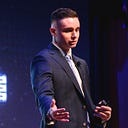Web3, The Web’s Digital Transformation
Written by Eugen Miscoi and Victor De Luca.
What is Web3?
The term Web3 (or Web 3.0) refers to an idea for the next version of the World Wide Web. By design, it is proposed that Web3 would be partially decentralized — meaning that there would be no central authority making decisions on what information can or cannot be shared. Instead, Web3 could enable its users to retain ownership of their data and maintain its integrity by leveraging blockchain technology.
To better understand the idea of Web3, a good understanding of the history of the Internet is key.
Web1
In the early 1990s, Web1 introduced a network of static pages that presented read-only information. This was the earliest version of the Internet, and it resembled a digital library of carefully curated information. Web1 did not allow companies to monetize viewership by presenting ads, nor did it allow users to log in and interact with the information presented to them.
Web2
Given the invention of Flash and JavaScript, along with the proliferation of computers and Internet access around the world, Web2 was created in the early 2000s. As the version of the Internet that we are most familiar with today, Web2 is a dynamic network of interactive pages that allows individuals to both read and write information. Over time, Big Tech companies found creative ways to collect and monetize the information of individuals — particularly their personal information — for marketing purposes. As such, the emergence of targeted ads and the erosion of individuals’ privacy became characteristic of Web2.
Web3
In response to Web2’s perceived flaws, and with the increased popularity of blockchain-based technologies in the early 2010s, an increasing number of individuals began advocating for the roll-out of Web3 as a decentralized alternative to Web2, with the privacy and freedom of speech of individuals as its core principles. Web3 would remain the interactive World Wide Web that we know today, with two key differences. On the one hand, each individual would own the information that they decide to publish on Web3, meaning that it cannot be erased, modified, or sold by a centralized organization. Rather, information could only be erased, modified, or sold by its owner on the blockchain, similarly to a non-fungible token (NFT). Additionally, Sir Tim Berners-Lee — an English computer scientist commonly credited with the invention of the Internet — suggested Web3 could be completely machine-readable by using semantics. This would guarantee the ownership of a piece of unique information on a Web3 platform.
On the other hand, every site on Web3 would be managed by a code-driven Decentralized Autonomous Organization (DAO) voted by its users and enforceable via a “smart contract” on the blockchain. DAOs would aim to effectively replace the roles of Big Tech CEOs that are currently shaping the way we interact on Web2. This could also prevent a small number of powerful organizations from taking control of Web3.
However, the opposite can also be true. By making access to Web3 significantly harder for users to interact with or understand, you might concentrate the power even further with blockchains that are partially or fully supported by only a single group of individuals or powerful corporations.
Lastly, the digital identity of individuals using Web3 is not connected to their offline identity. Consequently, users can navigate, create, and download content on Web3 under the veil of anonymity. This would not only protect the personal information of individuals but also redefine online marketing which will no longer be able to rest on targeted ads and the monetization of data about Internet users.
Further reading about a Web2 vs Web3 comparison can be found here.
Who are the main actors?
Recently, a16z also known as Andreessen Horowitz, a private venture capital firm from Menlo Park in California, released an interesting whitepaper called “The Web3 Landscape”. The whitepaper does not provide much information on the actual intent but does pique interest regarding what their future plans are. The backlash from tech gurus was almost quite immediate:
Sir Tim Berners-Lee, literally the founder of the Internet, gathered a team of technologist superheroes in the likes of Bruce Schneier and other PhDs and founded a startup called Inrupt. Inrupt offers a technology called Solid. Solid was initially the project of a collaboration between the MIT and a team led by Berners-Lee. Recently, the organization made the news by raising about 30 million dollars in its Series A financing round. Simply put, that service offers pods that essentially look like a Google Drive or a Dropbox account:
So what do we think?
Ultimately, Web3 remains a relatively new and radical idea. While its full-scale implementation is unlikely in the short term, its core values and increasing feasibility in light of new technological developments are likely to trigger some medium-to-long-term changes to Web2. Whether these changes amount to the creation of Web3 or evolution from Web2 towards Web2.1 will be determined by the scale of its adoption by users beyond blockchain enthusiasts.
Since venture capitalists from a16z that invested early in companies such as Okta, Coinbase, Pinterest and Slack are taking a good look at Web3-oriented ventures, it’s almost certain these new Web3-based ventures will be angled towards profits and potential IPOs. The how and when remains to be determined.
